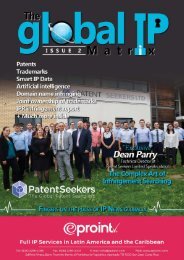Global IP Matrix - Issue 8
Dear Readers We are delighted to present you with issue 8 of The Global IP Matrix magazine! Once again, we have fantastic content delivered to you by industry professionals who are experts in their field. This issue explores IP & Innovation in Africa, anti-counterfeiting measures in the Caribbean, IPR Infringement in China, plus many more engaging articles around the IP ecosystem. It's been a challenging few months; however, we are grateful that our clients and contributors share our vision. Together, we are heading for better times. We cannot thank our authors enough for their time and efforts to keep you, our audience up to date with news and stories from their own perspective and expertise. Look out for our next edition, in January 2021 and until then, stay safe, healthy & happy. Elvin Hassan – Editor
Dear Readers
We are delighted to present you with issue 8 of The Global IP Matrix magazine!
Once again, we have fantastic content delivered to you by industry professionals who are experts in their field.
This issue explores IP & Innovation in Africa, anti-counterfeiting measures in the Caribbean, IPR Infringement in China, plus many more engaging articles around the IP ecosystem.
It's been a challenging few months; however, we are grateful that our clients and contributors share our vision. Together, we are heading for better times.
We cannot thank our authors enough for their time and efforts to keep you, our audience up to date with news and stories from their own perspective and expertise.
Look out for our next edition, in January 2021 and until then, stay safe, healthy & happy.
Elvin Hassan – Editor
Create successful ePaper yourself
Turn your PDF publications into a flip-book with our unique Google optimized e-Paper software.
Best methods for an effective
patent landscape analysis
in just six simple steps!
All of the greatest, most
renowned inventions start
with an idea.
Patents are often the only source of disclosure
of an invention, as most are never published
elsewhere. Hence, companies around the
world are protective of the value held in their
intellectual property and realise the importance
of monitoring the intellectual property of their
competitors.
As the rate at which new inventions are being
patented is ever-increasing, the continuous
monitoring of new patents is vital to ensure
corporate success and financial stability when
attempting to access new markets, exploit
existing ones, and scoping the profitability of
emerging products. Patent search and analysis
platforms, such as PatBase, are essential for
users to search, review, analyse and share
patent information, to harness the knowledge
found in patents, gain competitive intelligence
and build on the ideas of others to drive
innovation forward.
This article focusses on patent landscape
analysis, a process that helps inform policy
discussions, strategic research planning, and
technology transfer within a business.
What is a Patent
Landscape Analysis?
Publicly available patent data is an excellent
source of ideas and information that can be
used to identify opportunities and threats
to a business and improve its survivability
and profitability in the modern marketplace.
This information is of vital importance to
competitive intelligence, which makes use
of public information to accrue data on
competitors and the market environment to
drive strategic decision making. Businesses
that ignore patents as a potential source of
information risk building an incomplete
competitive intelligence picture and delaying
or even preventing innovation.
Authored by Caitlin Kavanagh, Marketing Manager at Minesoft, UK
www.minesoft.com
Patent landscape reports are intended to give a snapshot or overview of the patents in a specific
subject area or cover a technology type. Generally taking 1-2 weeks to complete, a landscape
report can cover hundreds or thousands of patent families. They can be used to visualise and
discover existing whitespace in relevant areas, gain actionable competitive intelligence by
understanding the current landscape, predict where your market is heading, and spot trends in
areas of interest to aid investment.
In this article, we have outlined six simple steps to help ensure an effective and comprehensive
patent landscape analysis.
Step 1 – Define goals
It’s important to understand what you’re trying to achieve through your patent landscape analysis
and clearly define these goals in advance. Depending on what the end goal is, you may want to
address some or all of these key questions (or come up with your own!) while conducting your
search.
• Is this a growing area of interest?
• What are the fields of current interest?
• Who are the key players?
• Where are the key players filing their inventions?
• Who are the “key opinion leaders” in this field?
• What is the legal status of the families in this area?
Step 2 – Broad overview
Once the scope of the study has been agreed upon, start reviewing the main articles and literature
on the topic. Studying a selection of basic literature will unearth some high-level keywords, as
well as identifying key players that are associated with the technology or subject area you’re
landscaping. Having a clear understanding of the area you’re investigating is critical when
analysing the final landscape and answering the key questions outlined above.
Using a commercial patent database, like PatBase, allows you to broaden your research by
investigating non-patent literature from trusted scientific resources.
Step 3 – Define your initial search strategy
After your preparation phase, you’ll need some time to devise a comprehensive search strategy.
Begin by generating general keywords used for the specific technology and build on that.
A successful search strategy should encompass keywords, classification codes, assignees, and
inventors. Searching your basic keywords within the title, abstract, and claims of patents will
help you discover additional relevant keywords and active assignees and inventors. Furthermore,
a statistical analysis of the IPC and CPC codes used to classify the initial answer set will identify
relevant classification codes to add to your search strategy.
Tools like the PatBase Thesaurus and Classification Explorer make it easier to compile a
comprehensive keyword search strategy with relevant synonyms from multiple languages and
to identify classification codes to broaden this strategy and find patents that may be missed by a
keyword search alone.
Results can now be narrowed down as needed, by limiting the geographical area, removing utility
models and design patents, removing irrelevant patent families identified by acronyms used in
multiple technology areas, and limiting by publication years. Focussing a search strategy can be
difficult and needs to be checked at every step to ensure relevant records are not eliminated. At
this juncture, you should have compiled a solid search strategy and be ready to run your initial
search.
Step 4 – Run an initial search
Once your results come back, take a quick review. Determine the percentage of your result set
containing relevant documents and judge whether it’s enough for a reliable patent landscape
analysis. Typically, if it’s 80% or more, your search strategy is sound.
A quick way of determining this is to use the Optimise function in PatBase and PatBase
Express and expanding the technologies categories (either IPC or CPC). This list shows the top
classification codes attached to the patent families found in the search. The list is ordered by most
frequently occurring technology codes across the entire result set. Make sure the most frequently
appearing classification codes are all relevant or identify new classification codes to include and
exclude the irrelevant ones.
It’s also important that the most important patents in the specified area are included in your
results. You can check this by sorting your answer set by “most cited” to reveal the most cited
publications in the area you’re landscaping and, therefore, the most significant.
Assuming your initial set meets your criteria, you can move on to Step 5.
Step 5 – Analyse and optimise your search
strategy
Improving your initial search requires identifying additional relevant keywords, classification
codes, active assignees, and inventors. Discover more keywords by reviewing classification
code definitions and checking the title and abstract of key patents. Depending on your subject
matter, you could expand your search further using a tool like Chemical Explorer, to specifically
search for any chemical terminology or structures across potentially millions of pages of patent
documents with just one click.
Top tips:
• For CPC and IPC classifications, use the codes from the basic keyword answer set to focus
your landscape.
• Identify the most frequently occurring assignees and inventors, ensure that areas in which
they are working are relevant by investigating their patent portfolio and website, and then be
sure to include their patent portfolio in your final landscape.
• Use advanced features in your patent
database, such as analytics, advanced
keyword highlighting, and cross-lingual
semantic searching to enhance the efficiency
and effectiveness of the review of patents
within your landscape.
• As many highly technical patents can be
100s of pages long, a tool like TextMine is
helpful to interrogate the patent text for
relevant key terms.
Step 6 – Visualise and
review
Visualise your landscape search by generating
statistical graphs. By viewing the data from
many angles (jurisdiction, year, assignee,
inventor, etc.) and at multiple levels (families,
priorities, applications, grants, etc.), you can
reveal answers to the key questions outlined
at the beginning of this article and easily draw
some conclusions; ensuring you stay focused
on your end goal.
Conclusion
Regular patent landscaping is crucial for
survival in any innovation-driven industry
to identify white space, monitor competitor
activity, and identify acquisition, licencing,
or collaboration opportunities. The world
of patent information continues to grow,
and patent search techniques are evolving
and becoming more complex. As a result, a
comprehensive patent landscape analysis can
be both time-consuming and complicated
– but Minesoft can help. Having access to a
comprehensive database of global patent data,
like PatBase, is a key first step but ensuring
a focussed and inclusive search strategy is
vital. The 6 simple steps outlined in this
article can help any user identify a complete
patent landscape and draw the appropriate
conclusions.
Minesoft offer several free whitepapers on
patent landscaping; access them at
www.minesoft.com.
PatBase, the online patent database, allows
you to optimise the way you search and review
patent literature. Trusted by top corporations
and law firms worldwide, our users rely on
PatBase as a robust and powerful platform
from which to search, review, share, and
analyse business-critical patent information.
16 www.gipmatrix.com www.gipmatrix.com
17












